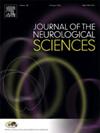基于倾向评分匹配的脑出血患者颅容积的短期预后价值
IF 3.6
3区 医学
Q1 CLINICAL NEUROLOGY
引用次数: 0
摘要
目的探讨颅脑容积是否能提高预后的准确性,探讨脑出血患者预后与颅脑容积及前后径的关系。方法收集哈尔滨医科大学第一医院2018 - 2020年诊断为自发性脑出血的患者资料。血肿体积与颅容积比(HVCVR)计算为血肿体积与颅容积的比值。建立多变量logistic回归模型来评估血肿体积和HVCVR的预测能力。采用倾向评分匹配来调整颅脑容积的基线差异。采用多元logistic回归模型探讨颅径与预后的关系。结果3494例患者中,不良预后1796例(51.4%)。较差的预后与较大的HVCVR值相关,多因素分析证实HVCVR是一个独立的预测因子(OR 1.722, 95% CI 1.471-2.206, P <;0.001),优于单独的血肿体积(AUC 0.774 vs. 0.761, P <;0.001)。倾向匹配队列(n = 1199)显示颅内容量越大与预后越好相关(OR 0.802, 95% CI 0.683-0.942, P = 0.002)。结论HVCVR能较准确地预测自发性脑出血患者的预后。颅脑容量增大和颅腔变平可能影响脑出血患者的积极预后。本文章由计算机程序翻译,如有差异,请以英文原文为准。
Short-term prognostic value of cranial volume in patients with cerebral hemorrhage based on propensity score matching
Objectives
The purpose of this study was to investigate whether cranial volume can improve the accuracy of prognosis, and to explore the relationship between the prognosis of patients with cerebral hemorrhage and the cranial volume and anterior and posterior diameter.
Methods
We obtained data from patients diagnosed with spontaneous cerebral hemorrhage between 2018 and 2020 at the First Hospital of Harbin Medical University. The hematoma volume to cranial volume ratio (HVCVR) was calculated as the ratio of hematoma volume to cranial volume. Multivariate logistic regression models were developed to assess the predictive power of hematoma volume and HVCVR. Propensity score matching was employed to adjust for baseline differences in cranial volume. Multiple logistic regression models were used to explore the relationship between cranial diameter and prognosis.
Results
Among 3494 patients, 1,796 (51.4%) had poor outcomes. Poor outcomes were associated with larger HVCVR values, and multivariate analysis confirmed HVCVR as an independent predictor (OR 1.722, 95 % CI 1.471–2.206, P < 0.001), outperforming hematoma volume alone (AUC 0.774 vs. 0.761, P < 0.001). Propensity-matched cohorts (n = 1199 each) revealed that larger intracranial volume correlated with better prognosis (OR 0.802, 95 % CI 0.683–0.942, P = 0.002).
Conclusion
Our study suggests that HVCVR provides a more accurate prediction of prognosis in spontaneous cerebral hemorrhage patients. Greater cranial volume and a more flattened cranial cavity may potentially influence positive prognoses in patients with cerebral hemorrhage.
求助全文
通过发布文献求助,成功后即可免费获取论文全文。
去求助
来源期刊

Journal of the Neurological Sciences
医学-临床神经学
CiteScore
7.60
自引率
2.30%
发文量
313
审稿时长
22 days
期刊介绍:
The Journal of the Neurological Sciences provides a medium for the prompt publication of original articles in neurology and neuroscience from around the world. JNS places special emphasis on articles that: 1) provide guidance to clinicians around the world (Best Practices, Global Neurology); 2) report cutting-edge science related to neurology (Basic and Translational Sciences); 3) educate readers about relevant and practical clinical outcomes in neurology (Outcomes Research); and 4) summarize or editorialize the current state of the literature (Reviews, Commentaries, and Editorials).
JNS accepts most types of manuscripts for consideration including original research papers, short communications, reviews, book reviews, letters to the Editor, opinions and editorials. Topics considered will be from neurology-related fields that are of interest to practicing physicians around the world. Examples include neuromuscular diseases, demyelination, atrophies, dementia, neoplasms, infections, epilepsies, disturbances of consciousness, stroke and cerebral circulation, growth and development, plasticity and intermediary metabolism.
 求助内容:
求助内容: 应助结果提醒方式:
应助结果提醒方式:


